
Autism Spectrum Disorder (ASD) is a neurodevelopmental condition that affects individuals across a spectrum, presenting with diverse strengths and challenges. Early identification of signs or “red flags” associated with autism is crucial for timely intervention and support. While it’s important to note that every individual is unique, there are common behaviors and characteristics that may indicate the presence of autism. This essay aims to explore the red flags of autism, providing insights into the social, communication, and behavioral aspects that often raise concerns.
Social Challenges
One prominent red flag of autism revolves around difficulties in social interaction. Children with autism may exhibit limited interest in others, particularly peers of the same age. Eye contact, a fundamental aspect of social communication, might be reduced or avoided altogether. Additionally, individuals with autism might struggle with understanding and responding appropriately to social cues, making it challenging for them to engage in reciprocal social interactions.
Moreover, a notable red flag is a lack of shared enjoyment or emotions. Typically, children begin to demonstrate shared attention and enjoyment through activities like pointing or showing objects to others. However, those with autism might not engage in such behaviors, potentially signaling challenges in developing joint attention and shared experiences.
Communication Delays and Differences
Another set of red flags often revolve around communication difficulties. Language development in individuals with autism may be delayed, with some exhibiting limited or absent speech. Others might develop language skills but face challenges in using language for social purposes, such as maintaining a conversation or understanding humor.
Echolalia, the repetition of words or phrases without apparent understanding, is a common communication red flag in autism. While echolalia can be a part of typical language development in some children, its persistence or lack of meaningful communication may raise concerns.
Additionally, individuals with autism may struggle with nonverbal communication. This includes difficulties in using gestures, facial expressions, and body language to convey their thoughts or understand others. The absence of pointing or waving, which is typically observed in early childhood, could be a significant red flag.
Repetitive Behaviors and Rigidity
The presence of repetitive behaviors and a preference for routine are often regarded as red flags associated with autism. Many individuals with autism engage in stereotypical and repetitive movements, such as hand-flapping, rocking, or spinning objects. These behaviors may serve as a way for individuals with autism to self-regulate or cope with sensory stimuli in their environment.
A strong resistance to change and a preference for sameness are additional behavioral red flags. Individuals with autism may become distressed when routines are disrupted, showing an intense need for predictability. This rigidity can extend to various aspects of their lives, from daily activities to specific interests or hobbies.
Sensory Sensitivities
Sensory sensitivities are common in individuals with autism and can serve as important red flags. Hypersensitivity or hyposensitivity to sensory stimuli, such as lights, sounds, textures, or smells, may manifest. Some individuals may be overwhelmed by seemingly minor stimuli that others can easily tolerate, while others may seek intense sensory experiences.
These sensitivities can impact an individual’s daily life, affecting their comfort and ability to engage in various environments. Observing reactions to sensory stimuli provides valuable insights into an individual’s sensory profile and can contribute to the identification of potential red flags associated with autism.
Early Intervention and Support
Recognizing these red flags is crucial for early intervention and support. Early diagnosis and intervention have been shown to significantly improve outcomes for individuals with autism, enhancing their social, communication, and behavioral skills. Various therapeutic approaches, such as Applied Behavior Analysis (ABA), speech therapy, and occupational therapy, can be implemented to address specific challenges associated with autism.
In conclusion, understanding the red flags of autism is essential for early identification and intervention. While these signs provide valuable insights, it’s important to approach each individual holistically, recognizing their unique strengths and challenges. By fostering awareness and promoting acceptance, we can create a more inclusive and supportive environment for individuals with autism to thrive.
Wesley Barrell
